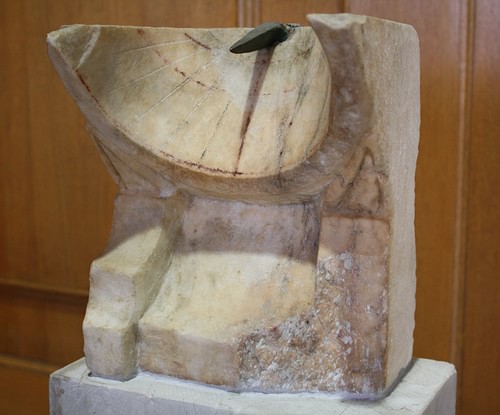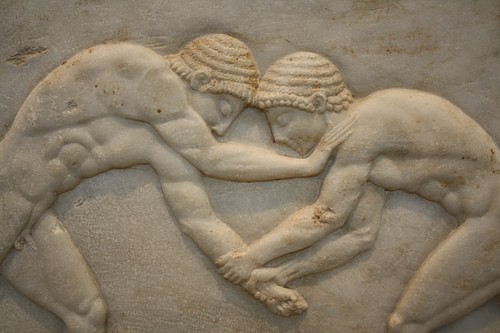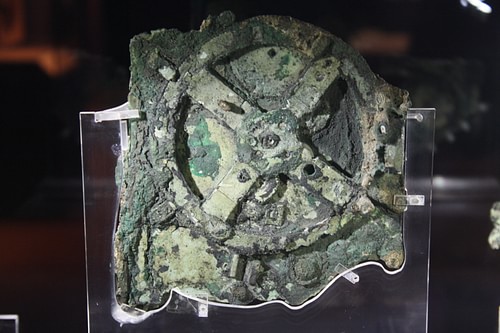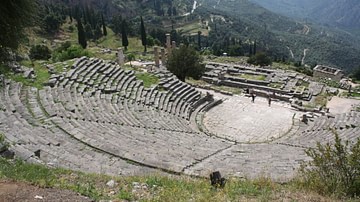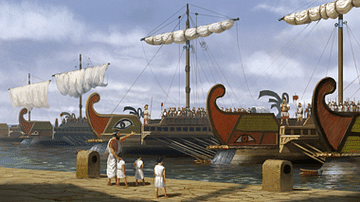The term “Athenian Calendar” (also called the “Attic Calendar”) has become somewhat of a misnomer, since Ancient Athenians never really used just one method to reckon the passage of time. Athenians, especially from the 3rd Century BCE forward, could consult any one of five separate “calendars:” Olympiad, Seasonal, Civil, Conciliar, and finally Metonic – depending on what event or type of event they wished to chronicle. Athenians, furthermore, either created these calendars for specific purposes or adopted them from others.
All Athenian calendars, however, used lunar cycles and/or solar events (typically solstices and equinoxes but also certain stars or constellations) to affix dates. These calendars also ran roughly from midsummer to midsummer, while days ran from sunrise to sunrise. Every Greek polis as well as other states about the Mediterranean, for example, Babylon & Egypt, all used their own unique calendars independently from each other. Athenian writers like Thucydides and Xenophon understood the difficulties and limitations of having competing systems.
Every Greek calendar possessed its own determinates and methodologies, and they all began on differing dates: Delphi's years began the first New Moon after the Summer Solstice; Boeotia and Delos began after the Winter Solstice; Chios began with the Vernal Equinox; whereas Sparta, Rhodes, Crete, and Miletos began with the Autumnal Equinox. Regardless, all Greek poleis originally regulated their calendars by the moon.
Lunar (synodic) months each contain 29.53 days (one lunar cycle). A twelve-month lunar year thus contains 354.36 days. A solar astronomical year, however, counts 365.24 days. Athenians understood from a very early time, especially with the advent of farming, that a lunar year fell 11 days short of a solar year. Any strict lunar calendar would therefore gain just over one synodic month in 3 years and drift through the seasons in 33-year cycles.
Nevertheless, Athenians did not abandon their lunar reckoning, because most of their annual festivals had become fixed by the phases of the moon (Geminus 8.7-8) – thus began the Athenian practice of ongoing periodical intercalations (deleting/inserting days and inserting months) designed to align the lunar and solar cycles. Athenians sought simply to keep these oscillations to a minimum. Scholars therefore refer to Athenian Calendars as “lunisolar.”
Understanding how the Athenian Calendars functioned (or those of any ancient Greek polis), or why they might make use of any one of them, requires first knowing the nature of the event dated, the precision an ancient chronicler desired, as well as the time period they resided, and the time period they needed to reference. Different calendars came into vogue at different times for different reasons and for different uses. Athenians would also make use of these assorted calendars with varying degrees of emphasis at different times in antiquity.
Olympiad Calendar
The Olympiad Calendar did not calculate dates in the modern sense as it does not count days nor even months but only years. Greek historians devised the Olympiad Calendar to provide a common frame of reference when reconciling historical events recorded by the local calendars of various poleis. This calendar became popular with later historical writers like Diodorus.
According to Plutarch (Numa 1.4), the 5th Century BCE sophist Hippias of Elis first recorded, and thus by consequence established, a canonical sequence of Olympic victors. The method soon found sporadic use (e.g. Thucydides 3.8.1; Xenophon, Hellenica 1.2.1). Eratosthenes of Cyrene crafted the final form of the Olympiad sequence in the 3rd Century BCE. The Olympiad Calendar, for example, becomes particularly important for interpreting the regnal years attributed to the Ptolemies, as transmitted through the works of Eusebius.
The Olympiad Calendar used the quadrennial athletic contests held at the Peloponnesian polis Olympia to render an acceptable common count of passing years. The four years between those successive games constituted one Olympiad. The Ancient Greeks, including Athenians, thus numbered their years first by noting the succession of the Olympic Games celebrated and then tallied the individual years until the next celebration.
Hippias had also determined Olympia first held these contests during the summer of 776 BCE. Since Greek years ran from summer to summer, historians render the First Year of the First Olympiad (i.e., Ol. 1.1) as 776/5 BCE. Thus:
- Ol. 1.2 = 775/4 BCE
- Ol. 1.3 = 774/3 BCE
- Ol. 1.4 = 773/2 BCE
- Ol. 2.1 = 772/1 BCE
The precise month and day each year began, that is, the nominal starting point for an Olympiad, remains uncertain. We know the lunar month in which Olympia held its games and festival typically fell between the first and second full moon following the Summer Solstice of the year in question (very roughly mid-August). The celebratory festival, moreover, would take place on the second full moon with the actual athletic contests unfolding over the previous few days. We also understand that, since the Olympic Games were PanHellenic (participants gathering from across all of Greece), ancient Greeks determined the next festival would occur in alternating intervals of 49 and 50 lunar cycles each quadrennial. They thus knew when to return. Ancient Athenians and other Greeks used the Olympiad Calendar only for historical purposes as its inherent imprecision rendered it completely inadequate for everyday life.
Parapegma (Seasonal) Calendar
Ancient Athenians also make reference to a Seasonal Calendar, the παράπηγμα (parapegma; pl. parapegmata) sometimes referred to by scholars as the “Greek Almanac.” Unlike the Olympiad Calendar, however, the Seasonal Calendar did not calculate dates in successive years but rather noted specific visible astronomical phenomena within a given year. Thus, we too would not consider it a true calendar in the modern sense.
Catalogued for centuries by various astronomers, parapegmata recorded either on stone or parchment a list of seasonally recurring weather changes in relation to the first and last appearances of stars and/or constellations alongside solar events like equinoxes and solstices – along with, in many cases, the phases of the moon. The primary need for a Seasonal Calendar emerged because Ancient Greeks needed to mark the beginning of weather changes to regulate certain human activities such as agriculture, navigation, and warfare.
More specifically, a Seasonal Calendar observed the first and last risings above the horizons of certain stars and particular constellations (at either sunrise or sunset) in relation to the equinoxes and solstices to mark important dates. Athenians then keyed the first appearance of specific stars and constellations to certain tasks. For instance, Hesiod (Works and Days) tells farmers to harvest when Pleiades rises. Ptolemy, furthermore, advocated that astronomical phenomena actually caused the changes in seasonal weather.
Some parapegmata included observations on other annual phenomena like eclipses, bird migrations, or they might track the sun's path through zodiac signs. Some of them also aligned the lunar cycles with solar cycles through intercalations of alternating 12 and 13 synodic months in a 19-year cycle (see Metonic Calendar below). An example of a parapegma might read something like:
- We begin with the summer solstice.
- The sun passes through Cancer in 31 days.
- Day 1: Cancer begins to rise. Sign of changing weather.
- Day 9: South Winds begin
- Day 11: Orion rises as a whole in the morning.
- Day 16: Corona begins to set in the morning.
- Day 23: Sirius first appears in Egypt
- Day 25: Sirius rises in the morning
- Day 27: End of Cancer rising. The Etesian winds blow for the next 53 days.
- Day 28: Aquila sets in the morning. There will be a storm at sea.
- Day 30: Leo begins to rise. South wind blows.
Athenians and other Greeks engraved important astronomical events on stone tables with drilled holes for movable wooden pegs to track the passage of the required stellar observations. In other cases, like the one cited above, they simply presented the observations in written texts. We know of several parapegmata, some authored by one individual, while several authors compiled others. The Ancient Greek astronomer Euctemon, who observed the Summer Solstice at Athens in 432 BCE, composed the earliest known systematic parapegma. We have also uncovered the oldest known example of a stone and peg parapegma in the Ceramicus district of Athens.
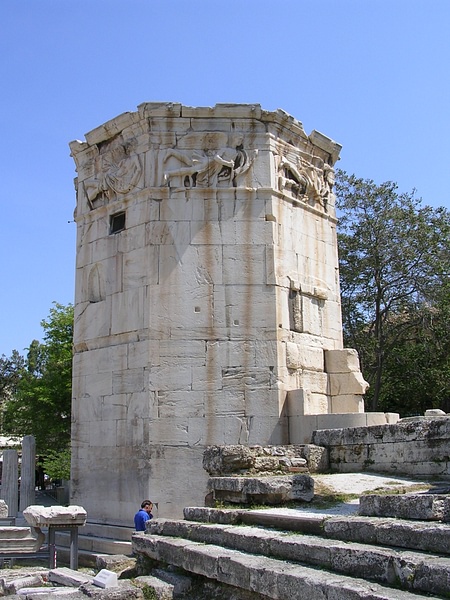
Athenian Civil Calendar
The most common use of the term “Athenian Calendar” today, nonetheless, typically refers to Athens' Civil (or Festival) Calendar. It has become the calendar about which we possess the most information and detail. The Athenian Civil Festival Calendar also comes closest to what we today would consider a “true” calendar. Athenians used this calendar primarily to regulate the numerous Athenian festivals throughout a given year. Athenians divided their festivals into two types: approximately 80 annually recurring celebrations and then sets of monthly festivities clustered around the beginning of each synodic month.
Much like some parapegmata, the Athenian Civil Calendar used lunisolar years comprised of 12 or 13 lunar months. Athenians named their synodic months after the chief festival, which occurred during that lunar cycle. Athenians then aligned those annual cycles as close as possible to the Summer Solstice of each subsequent year using intercalations (inserting a periodic 13th synodic month).
Like the Olympiad Calendar, Athenians also tracked succeeding years of the Civil Calendar. They recorded the name of the Eponymos Archon (or simply Archon), who served a given year. By the 5th Century BCE, the Archon had come to oversee the annual religious festivals, and thus by consequence became responsible for maintaining the Civil Calendar. The actual term “Eponymos Archon,” however, does not enter Greek texts until the Roman period.
The evidence suggests Athenians inscribed their Archons on stone in a single official list. Scholars today typically divide this Archon List into three periods:
- Inception to 481/0 BCE
- 480/79 to 302/1 BCE
- The Hellenistic Period to 101/0 BCE.
Greek historians, moreover, would reference their Archon Years to date events one of two ways:
- Simply to note an already recorded connection between some event and an Archon's name; or
- Use the Archon's name to denote the specific year in which an event occurred.
Thucydides, for example, dates the start of the Peloponnesian War to the final lunar months during the Archonship of Pythodorus (2.2.1).
After Hippias of Elis published his list of Olympic victors, furthermore, various Ancient Greek chronologists began to draw up comparative tables against Athenian Archons as well as other annual lists maintained in other poleis (e.g., Spartan Ephors and the Argive Priestesses of Hera).
Ancient Athenians could (and scholars today can) thus determine years like so:
- Ol. 72.1 = Archonship of Hipparchus = 492/1 BCE
- Ol. 72.2 = Archonship of Hybrilides = 491/0 BCE
- Ol. 72.3 = Archonship of Phaenippus = 490/89 BCE
- Ol. 72.4 = Archonship of Aristides = 489/8 BCE
- Ol. 73.1 = Archonship of Anchises = 488/7 BCE
The Twelve Athenian Civil Lunar months (in order) were:
- Hekatombaion
- Metageitnion
- Boidromion
- Pyanopsion
- Maimakterion
- Poseidon
- Gamelion
- Anthesterion
- Elaphebolion
- Mounikhion
- Thargelion
- Skirophorion
Each month began with the New Moon and lasted 29 or 30 days (one lunar cycle) to render 354/5 day years. The Eponymos Archon occasionally (and apparently somewhat haphazardly) intercalated a year by inserting a 13th lunar month, which typically (though not always) became a second Poseidon. This process kept the Civil Calendar in line with the seasons. Intercalated years thus possessed 384 days. Each Civil Year would begin about the first New Moon after the Summer Solstice (Hekatombaion 1).
Athenians used two different types of months to denote each lunar cycle: Full months of 30 days and Hollow months of 29 days. Omitting certain days in certain months compensated for the fact two lunar cycles equalled 59.06 days. The precise methodology an Archon would use to determine first when to omit a day and then secondly, which day to omit, has become a matter of contention amongst scholars. We know only that the omission occurred during the last third of a lunar cycle.
Athenians divided each synodic month into two phases of 10 days each and then a third phase, which varied in number between Full and Hollow months: the waxing moon, the full moon, and then the waning moon. They called the first day of each month νουμηνία (noumenia) or "new moon." They counted up to the 20th day and then counted down to the last day of each lunar cycle. Athenians, strictly speaking, simply numbered their days only during the second phase (the 11th through the 19th of each month). Athenians, for example, called the 5th of each month the “5th moon rising” and the 24th of each month the “7th moon waning.” Moreover, Athenians sometimes referred to the 20th as either the “20th” or the “10th before.” They called the final day of the month ἕνη καὶ νέα (hene kai nea) or “old and new.”
Scholars also disagree over how much consideration Athenians gave ongoing astronomical observations against strict mathematical computations with regard both to declaring Full versus Hollow synodic months throughout the year as well as when to intercalate a 13th lunar cycle. Nevertheless, the Ancient Athenians had come to realize that, by the middle of the 5th Century BCE, their Festival Calendar had grown notoriously complex and much too often deviated out of alignment with key events from the Solar Year and, in many cases, the Seasons themselves. They attempted reforms to this calendar in 407/6 BCE (see Metonic Calendar), though they never actually abandoned it.
Conciliar Calendar
Beginning sometime in the late 6th Century BCE (or by the mid-5th Century BCE), the Ancient Athenians also used an independent ten-month Conciliar Calendar, where each month marked the successive rotating terms for the presiding Prytany (presidency). Each Prytany represented one of the ten Attic Phyles (tribes) in the Athenian Boule (Council of Five Hundred).
We today would also consider the Conciliar Calendar a “true” calendar, but Athenians used it in only one real capacity: to record and date financial transactions as proposed by the Boule and approved by the Ekklesia (Assembly). Those transactions might include tribute assessments, tax collections, the dispensing of public funds (building construction, festivals), loans to cults, payment of wages, and calculating interest. Some scholars will thus refer to the Conciliar Calendar as the Senatorial, Fiscal, or Bouletic Calendar.
The original ten Conciliar Months (Prytanies) were:
- Erektheis
- Aigeis
- Pandionis
- Leontis
- Akamantis
- Oineis
- Kekropis
- Hippothontis
- Aiantis
- Antiokhis
Each month would then last 35-38 days, divided more or less equally though apparently somewhat ad hoc to render 365/6 day years. The Conciliar Year also ran from midsummer to midsummer but did not become officially coterminous with the Civil Calendar until 407/6 BCE. Athenians determined by lot the actual order in which Prytanies served every year, and that began initially a week after the Summer Solstice (Prytany 1, 1). It thus became the Athenian near equivalent of a true solar calendar.
Aristotle (Ath. Pol. 43.2) writes that the first four Prytanies possessed 36 days each while the last six had 35 days each, which can apply only after the Athenians aligned the first days of the Conciliar and Civil Calendars in 407 BCE (i.e., Hekatombaion 1 = Prytany 1, 1), and then by also making the Conciliar Calendar lunisolar. Even then, however, they did not follow the formula strictly. Prior to the 4th century BCE, moreover, the start of Conciliar and Civil Calendars aligned only haphazardly and sporadically. Whether or not Athenians intended these alignments through manipulation or the alignments simply occurred by happenstance remains debated amongst scholars as well.
The number of Tribes, moreover, did not remain constant, and the lengths for each Bouletic month adjusted accordingly. Athens created two Macedonian Tribes in 307/6 BCE, and thus the Conciliar Year became divided into 12 Prytanies. They created a 13th Tribe in 224/3 BCE, and then they abolished the two Macedonian Tribes in 201/0 BCE, resulting in 11 Prytanies. Athenians soon created a new 12th Tribe, which remained set until 126/7 CE, and then they created yet another Tribe. This resulted in 13 Prytanies until the dissolution of the Boule.
The bulk of our information regarding the Conciliar Calendar comes from various inscriptions. Athenians would record, in the preamble of their financial decrees, the name of the Tribe the Prytany represented, the name of the recording Secretary, and the name of the presiding Officer. We can determine the year a specific financial transaction took place as long as we know who served as the Secretary of the Boule for that year. In addition, several inscriptions rate the accounts by Prytany and date the transaction by Archon. We can also uncover the length of a specific Bouletic Month of a given year if the Athenians recorded any interest accumulated on loans made, but these references remain sporadic at best.
With the sole exception of the first day, however, Athenians never systematically aligned their Civil and Conciliar Calendars (i.e. 12 synodic months versus 10, 11 or 13 Bouletic months), and they never devised a formulaic methodology to equate dates between their independent calendars. Scholars can approximate equivalencies between the two by calculating the number of days between separately recorded transactions from sporadic references in either or both calendars, but such equations become notoriously complex and involved (especially prior to 407 BCE).
Metonic Calendar
Athenians also used an enneakaidekaetris: a Nineteen Year Lunar-Solar Cycle or Metonic Calendar. The 5th-century BCE Athenian astronomer Meton introduced this calendar in 432 BCE. He calculated that a period of 19 Solar Years almost exactly equalled 235 Lunar Months (the difference being a number of hours). Once rounded, each cycle counted 6,940 full days. A Metonic Cycle errs one full day every 219 years.
Athenians could then systematically and accurately align their two astronomical calendars (solar and lunar) using a formulaic method of 125 Full months (30 days) and 110 Hollow months (29 days), while also intercalating 7 years during the course of the cycle (235 = 19 × 12 + 7). The first Metonic Cycle ran from the Summer Solstice of 432 BCE to the Summer Solstice of 413 BCE.
Meton appears to have followed earlier Babylonian astronomers and then adopted his calendar to the Athenian Civil Calendar. Meton's 19-year cycle of 235 synodic months began with the New Moon just after the Summer Solstice. Babylon's 19-year cycle, on the other hand, began with the first appearance of the crescent moon after the Spring Equinox. Nevertheless, Babylon had incorporated their cycle toward the end of the 6th century BCE. How closely the Epynomous Archons came to follow Meton's new scheme also remains debated.
The Callipic Cycle
A century later, Callippus of Cyzicus, who studied at Plato's Academy, had more accurately calculated the duration of a solar year at 365 + 1/4 days. He therefore simply multiplied the 19-year Metonic Cycle by 4 and then omitted 1 day from the last 19-year cycle. He thus discovered another solar cycle of 76 years that consisted of 940 lunar cycles or 27,759 days. The first Callippic Cycle began with the Summer Solstice of 330 BCE. He too used the Athenian Civil Calendar synodic months to establish this lunisolar calendar. Later astronomers like Ptolemy made use of the Callippic Cycles.
Comparing Calendars
When scholars attempt to convert known dates from the various calendars Athenians used to their Julian equivalents, the difficulties encountered swing from the ease of straightforward determinations on the one end of the pendulum to exceptionally byzantine and supremely involved equations on the other end.
On the one hand, the years of each Olympiad as well as the list of Athenian Archons have become (with the exception of the occasionally debated error) established and, for the most part, universally recognized. In addition, if ancient authors reference a known astronomical event (eclipse, solstice, equinox, etc.) then that conversion proves straightforward and exact. For example, Thucydides (4.52) records a partial eclipse of the sun, which took place in Greece during the first days of the 8th Summer after the start of the Peloponnesian War, which he had already dated to the Archonship of Pythodorus (2.2.1). This eclipse occurred on 24 March 424 BCE.
On the other hand, when scholars begin to examine equivalencies between the Athenian Seasonal, Civil and Conciliar Calendars, the problems become exponentially more complex. Established synchronisms between the Athenian Seasonal and Civil Calendars and their Julian equivalents exist only in the broadest form, because of the haphazard process of intercalation (even after the introduction of the Metonic Cycles). For example, the most widely accepted schema provided today dictates:
Summer
- Hekatombaion: July/August
- Metageitnion August/September
- Boedromion September/October
Autumn
- Pyanepsion October/November
- Maimakterion November/December
- Poseideon December/January
Winter
- Gamelion January/February
- Anthesterion February/March
- Elaphebolion March/April
Spring
- Mounikhion April/May
- Thargelion May/June
- Skirophorion June/July
The Ancient Athenians only loosely followed it. The actual date of Hekatombaion 1, that is, the 13th or 14th New Moon in succession from the start of the previous year, could occur anywhere from as early as mid-June to as late as mid-August the following year. Thucydides, furthermore, also remains notoriously loose at referencing seasons during his account of the Peloponnesian War.
In addition, with the single exception of the Summer Solstice, no such equations exist for the Conciliar Year. Prytany 1,1 fell consistently, more or less, during the first week of July (prior to 407 BCE), but the Conciliar Year might begin anywhere from mid-Thargelion to late-Hekatombaion.
With the absence of any computations on interest for specific loans, moreover, the exact length of any subsequent Bouletic Month within any given year remains unknown.
If a scholar desires to uncover a more precise Julian date for a specific Athenian or Greek event, then they must first construct a table between the Civil and Conciliar Calendars (when possible), and populate it with as much information as available gathered from inscriptions and textual evidence. Nevertheless, wading into the excessively sophisticated and specialized debates regarding these two calendars remains a most hazardous excursion even for the expert. An infamously long (and often vitriolic) controversy erupted between Professors Benjamin Meritt and William Pritchett over Attic time-reckoning.
The arguments occasionally transcended studies of the calendars themselves to include disagreements over specific assumptions and methodologies, proposed restorations, and even Attic epigraphy itself. Scholars will encounter both duelling epigraphical reconstructions, judgments on the textual evidence, and then disagreements over specific equations (Full and Hollow months versus Intercalary Years), which seek to align the two calendars using known fixed points. The disagreements become so abstruse that, for decades, few scholars have even ventured into the jungle. Nevertheless, reconstructing this methodology becomes paramount for any precise conversions to Julian dates to take place, but any conclusion will still possess a significant margin of error.
Lastly, Historians and Classicists commonly provide Julian dates (when known) for those years that fall before the introduction of the Gregorian Calendar in 1582 CE. To determine Gregorian dates during the Classical and Early Hellenistic Periods (500-300 BCE), subtract 5 days; for the late Hellenistic Period to the early Roman Republic Period (300-200 BCE), subtract 4 days; for mid to late Roman Republic periods (200-100 BCE), subtract 3 days.
